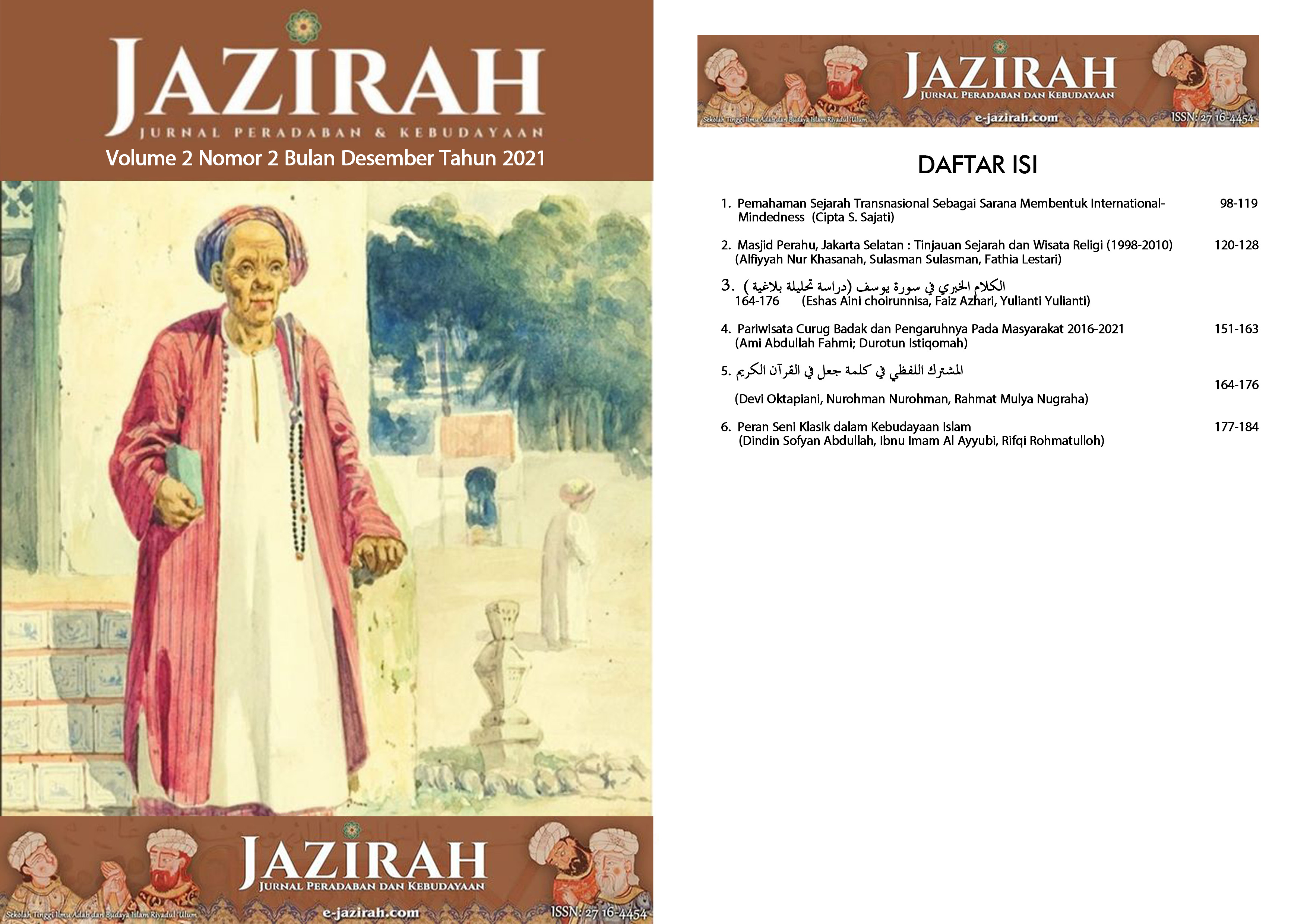PERAN SENI KLASIK DALAM KEBUDAYAAN ISLAM
Main Article Content
Abstract
Islam is closely related to the aesthetics of classical art, this is enlivened by elements of culture that have such a large influence on various fields, including the fields of education, language, law, politics, philosophy, ethics, rhetoric, and art itself. Classical art is a manifestation of fine art made by the people according to the culture in a certain area for generations, inherent in the flesh so it is difficult to experience significant changes from time to time. The method used in this study is a descriptive qualitative research method with a literature study approach that refers to several research data sources and data collection techniques in the form of studies of Islamic classical art. The focus of the research that will be raised is the role of classical art in Islamic culture. The data collection technique used in this study was the library research method, namely library research and the data analysis technique used in this study was a descriptive method. Based on the research conducted, it can be concluded that classical art is inherent in Islamic religious culture, where there are ritual ceremonies that are thick with the Islamic religion, both in primitive and classical styles.
Downloads
Article Details
Authors who publish with this journal agree to the following terms:
- Copyright on any article is retained by the author(s).
- The author grants the journal, right of first publication with the work simultaneously licensed under a Creative Commons Attribution License that allows others to share the work with an acknowledgment of the work’s authorship and initial publication in this journal.
- Authors are able to enter into separate, additional contractual arrangements for the non-exclusive distribution of the journal’s published version of the work (e.g., post it to an institutional repository or publish it in a book), with an acknowledgment of its initial publication in this journal.
- Authors are permitted and encouraged to post their work online (e.g., in institutional repositories or on their website) prior to and during the submission process, as it can lead to productive exchanges, as well as earlier and greater citation of published work.
- The article and any associated published material is distributed under the Creative Commons Attribution-ShareAlike 4.0 International License
References
Hum, W. M. (2017). Menatap Masa Depan Peradaban Islam. Ishraqi, 1(1), 31–39.
Ismail, H. F. (2017). Sejarah & Kebudayaan Islam Periode Klasik. IRCiSoD.
Jinan, M. (2010). Kaligrafi Sebagai Resepsi Estetik Islam. Suhuf, 22(2), 142–156.
Kadir, N. A. A., Dahalan, N. N. N., & Jamaludin, N. (2018). Seni dalam Islam: Kajian khusus terhadap seni ukir. E-Journal of Islamic Thought and Understanding, 1(30 January), 1–15.
Kalsum, N. U. (2014a). Perkembangan Pemikiran dan Peradaban Islam Pada Abad Modern. Tamaddun: Jurnal Kebudayaan Dan Sastra Islam, 14(2), 163–178.
Kalsum, N. U. (2014b). Perkembangan Pemikiran Dan Peradaban Islam Pada Abad Modern. Tamaddun, 14(2), 163–178.
Piliang, Y. A. (2019). Seni, Desain dan Kebudayaan dalam Spirit Revolusi Industri 4.0. SENADA (Seminar Nasional Manajemen, Desain Dan Aplikasi Bisnis Teknologi), 2, 1–9.
Pramono, A. (2012). Pola geometri pada seni dan arsitektur Islam di andalusia. Journal of Islamic Architecture, 1(3).
Rofiq, A. C. (2017). Sejarah Islam Periode Klasik. Penerbit Gunung Samudera [Grup Penerbit PT Book Mart Indonesia].
Safliana, E. (2018). Seni Dalam Perspektif Islam. Jurnal Ilmiah Islam Futura, 7(1), 100–107.
Sunanto, M. (2007). Sejarah Islam Klasik: Perkembangan Ilmu Pengetahuan Islam.
Tadjuddin, M. S., Sani, M. A. M., & Yeyeng, A. T. (2016). Dunia Islam dalam Lintasan Sejarah dan Realitasnya di Era Kontemporer. Jurnal Ushuluddin: Media Dialog Pemikiran Islam, 20(2), 345–358.
Wildan, R. (2018). Seni dalam Perspektif Islam. Jurnal Ilmiah Islam Futura, 6(2), 78–88.
Zainuri, A. (2021). Integrasi Islam dan Budaya Lokal dalam Seni Arsitektur Masjid Kuno di Jawa: Sebuah Tinjauan Umum. Heritage, 2(2), 125–144.

